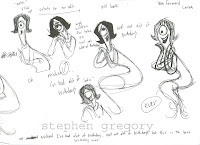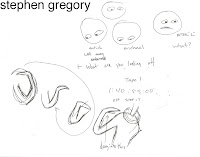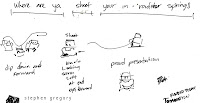Want to se some good drawing?
go here
the Firehouse Stomp
and here
Temple of the Seven Golden Camels
or here
Drawings From A Mexican
there's tons more if you follow the links from these blogs.
-Dr. Stephen G.
Animators by day Animation teachers by night.
go here
Many students get really intimidated when they are asked to draw or do thumbnails and show them in class. It's understandable, now days you don't have to be a great draftsman to get into animation school, heck for some schools you can have never drawn anything and get in. Computer animation has liberated many great animators, who may never been able to get into animation due to their lack of drawing ability. So on one hand the computer has allowed so many more people to access animation as a career and also allowed animation to become as big as it is these days, from computer games to the Internet, to commercials, feature animation etc. The flip side is that because of this access and the possible feeling that drawing doesn't relate to computer animation, the overall quality of the animation being produced is getting weaker and weaker. Many students now days can go to school learn everything there is about Maya, and graduate with only taking a few drawing classes and possibly never taking story or design classes. It's really a shame, for one that students don't demand story, design and drawing classes and also that schools don't find them important to the curriculum of computer animation. I had four main classes at Cal-Arts that repeated every semester for four years; Story, Character Design/Design, Animation, Life Drawing.






There was a comment in the last post about Walt Stanchfield's amazing drawing notes, which you can get at animationmeat.com, about how some students or even non-students dismiss these because they feel it only relates to 2d animation and doesn't relate to 3d computer animation. I guess this might be why people are always looking for books on computer animation which is silly. Animation is Animation. Animation as and art form or craft exists outside of the medium your using. It really doesn't matter if your working in clay, sand, pencil, computer, paper cut out, or any medium the principles of animation exist in all of these. The principles of animation exist outside of these mediums. So anything that would help in one medium would also help in the others. As far as drawing goes, and learning to draw or understanding the principles of design and composition these are some of the most important things we can have as animator to help tell our stories. So to dismiss these ideas and concepts because, you are not a graphic designer, a cinematographer or a 2d animator is really just hurting you as an animator. The best animators I've come across are really talented at all of these things, Design, Composition, Acting, Music, Dance, Film history, Observation, Drawing, Story Telling, Attention to detail, Physics, and Passionate. I've always believed that what makes animation so hard to master, is that you have to have an understanding of so many things. Like being able to understand body mechanics and human emotion to having the ability to draw like Rembrandt. And then having some concept of almost everything in between. It's hard trust me, and I myself am no where near knowing all of it. The only thing I do know is the people that tend to be better at all of these things tend to be better animators.




A Comment from the last post about reading the Illusion of Life.




Sorry its been a while since our last post. Ratatouille is finishing up. Animation has wrapped and we are all taking a breather. Adam and I are planning to do some more Animation Roundtables as well as some new Spline Casts... Stay tuned.